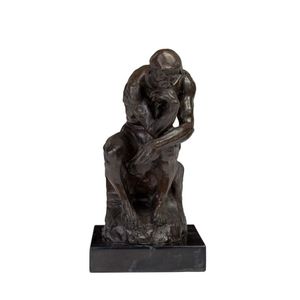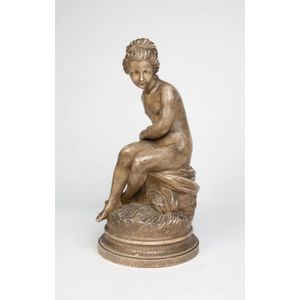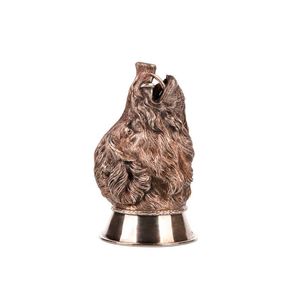Russian Silver Boar Stirrup Cup, Moscow 1885
Impressive Russian silver stirrup cup, mark of Andrei Alexandrov, Moscow, 1885, modelled as a boar with open mouth and encircled by a rope work girdle, with gilded interior, hallmarked, 84 standard, approx. Weight 744 grams height 19.5 cm diameter 11.7 cm, labels: Cf. For comparison Christie's, London, sale no. 9698, 26 November 2013, lot 320
You must be a subscriber, and be logged in to view price and dealer details.
Subscribe Now to view actual auction price for this item
When you subscribe, you have the option of setting the currency in which to display prices to $Au, $US, $NZ or Stg.
This item has been sold, and the description, image and price are for reference purposes only.
- Hallmarks - A mark stamped on articles of precious metals in Britain, since the 14th century, certifying their purity. It derives its name from the Guild Hall of the Goldsmiths' Company, who recieved its Charter in 1327 giving it the power to assay (test the purity) and mark articles of gold and silver.
The hallmark will consist of several marks, including the:
- silver standard mark, indicating the purity of the metal. Sterling silver is .925 pure silver.
- the city mark indicating the city in which it was assayed eg London, Birmingham, York etc.
- the date mark, usually a letter of the alphabet in a particular font and case,
- a duty mark, indicating whether duty had been paid to the crown, and only in use from 1784 to 1890
The piece may include an additional mark, the maker's mark, although not forming part of the hallmark, will be located in the vicinity of the hallmarks.
Sometimes silver plated items will bear faux hallmarks, often confusing those not familiar with silver markings. - Gilding - Gilding is a method of ornamentation whereby a thin sheet of gold metal is applied to items made of wood, leather, ceramics, glass and silver for decorative purposes.
For furniture including mirrors, the sheet of gold is usually applied over a coating of gesso. Gesso is a mixture of plaster of Paris and gypsum mixed with water and then applied to the carved wooden frames of mirrors and picture frames as a base for applying the gold leaf. After numerous coats of gesso have been applied, allowed to dry and then sanded a coat of "bole", a usually red coloured mixture of clay and glue is brushed on and allowed to dry, after which the gold leaf is applied. Over time parts of the gilding will rub off so the base colour can be seen. In water gilding, this was generally a blue colour, while in oil gilding, the under layer was often yellow. In Victorian times, gilders frequently used red as a pigment beneath the gold leaf.
Metal was often gilded by a process known as fire gilding. Gold mixed with mercury was applied and heated, causing the mercury to evaporate, the long-term effect of which was to kill or disable the craftsman or woman from mercury poisoning. The pursuit of beauty has claimed many victims, not the least of which were the artists who made those pieces so highly sought after today.
This item has been included into following indexes:
Visually similar items

A French bronze figure of 'The Thinker' after Auguste Rodin, by Demetre Chiparus, signed, onyx base, 30 cm high
Sold by
in
for
You can display prices in $Au, $US, $NZ or Stg.

A bronze bust of Shakespeare signed Blot 67 cm high
Sold by
in
for
You can display prices in $Au, $US, $NZ or Stg.

A Chinese bronze food dog. Height 8 cm. Length 9 cm
Sold by
in
for
You can display prices in $Au, $US, $NZ or Stg.

A painted terracotta figure, after Falconet, French circa 1880, 58 cm high
Sold by
in
for
You can display prices in $Au, $US, $NZ or Stg.
